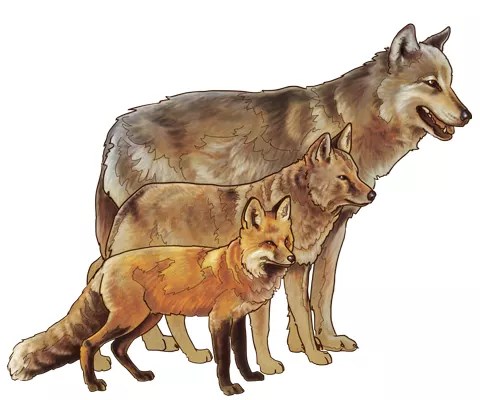
NPS/Corey Lycopolus Coyotes are intelligent and adaptable. They can be found throughout North and Central America, thriving in major urban areas as well as in remote wilderness. This adaptability helped coyotes resist widespread efforts early in the 1900s to exterminate them in the West. The coyote is a common predator at Valles Caldera, often seen traveling through the park's montane grasslands. 
DescriptionOften mistaken for a wolf, the coyote is about one-third of a wolf's size with a slighter build. Its coat colors range from tan to buff, sometimes gray, and with some orange on its tail and ears. Males are slightly larger than females. During the 1900s, coyotes across the West partially filled the niche left vacant after wolves were largely exterminated. Following the eradication of wolves in Yellowstone, for example, coyotes formed packs or family groups of up to seven animals. This social organization is characteristic of coyotes living in areas free from human hunting. With the reintroduction of wolves, Yellowstone coyotes returned to a more typical social organization—pairs with pups. At Valles Caldera, packs of five to seven coyotes can sometimes be seen hunting cooperatively, particular during elk calving season. During the remainder of the year, it is more common to see coyotes traveling solo or in small groups of two to three animals. Coyotes, also known as “song dogs,” communicate with each other by a variety of long-range vocalizations. You may hear groups or lone animals howling, especially during dawn and dusk periods. Coyotes also mark with their scent (urine and feces) to communicate their location, breeding status, and territorial boundaries. Coyotes, Humans, and PetsThe coyotes of Valles Caldera are a resilient and durable species that have persisted in this landscape despite countless setbacks. Visitors to Valles Caldera can help protect this species, their pets, and themselves by understanding coyote behavior, knowing where pets are permitted, and maintaining a safe distance from all wildlife. Related ArticlesResourcesCarrera, Rogelio, Warren Ballard, Philip Gipson, Brian T. Kelly, Paul R. Krausman, Mark C. Wallace, Carols Villalobos, and David B. Webster. 2008. “Comparison of Mexican Wolf and Coyote Diets in Arizona and New Mexico.” The Journal of Wildlife Management 72, no. 2 (February). 377-78. Crabtree, R.L., and J.W. Sheldon. 1999. Coyotes and canid coexistence in Yellowstone. Pages 126–163 in T. W. Clark, et al, editors. Carnivores in Ecosystems: the Yellowstone Experience. New Haven: Yale University Press. Flores, Dan. 2017. Coyote America: A Natural and Supernatural History. New York: Basic Books. Gese, E.M. et al. 1996. Foraging ecology of coyotes: the influence of extrinsic factors and a dominance hierarchy. Can. J. Zool. 74:769–783. Gese, E.M. et al. 1996. Social and nutritional factors influencing dispersal of resident coyotes. Anim. Behav. 52:1025–1043. Gese, E.M. and R.L. Ruff. 1997. Scent-marking by coyotes: the influence of social and ecological factors. Anim. Behav. 54:1155–1166. Gese, E.M. and R.L. Ruff. 1998. Howling by coyotes: variation among social classes, seasons, and pack sizes. Can. J. Zool. 76: 1037–1043. Gese, E.M., T.E. Stotts, and S. Grothe. 1996. Interactions between coyotes and red foxes in Yellowstone National Park, Wyoming. Journal of Mammalogy 77(2):377–382. Gese, E.M., R.L. Ruff, and R.L. Crabtree. 1996. Intrinsic and extrinsic factors influencing coyote predation of small mammals in Yellowstone National Park. Canadian Journal of Zoology 74(5):784–797. Moorcroft, P.,M. A. Lewis, and R.L. Crabtree. 1999. Home range analysis using a mechanistic home range model. Ecology 80:1656–1665. Moorcroft, P.R., M.A. Lewis, and R.L. Crabtree. 2006. Mechanistic home range models capture spatial pat- terns and dynamics of coyote territories in Yellowstone. Proceedings of the Royal Society Biological Sciences 273:1651–1659. |
Last updated: January 17, 2024
